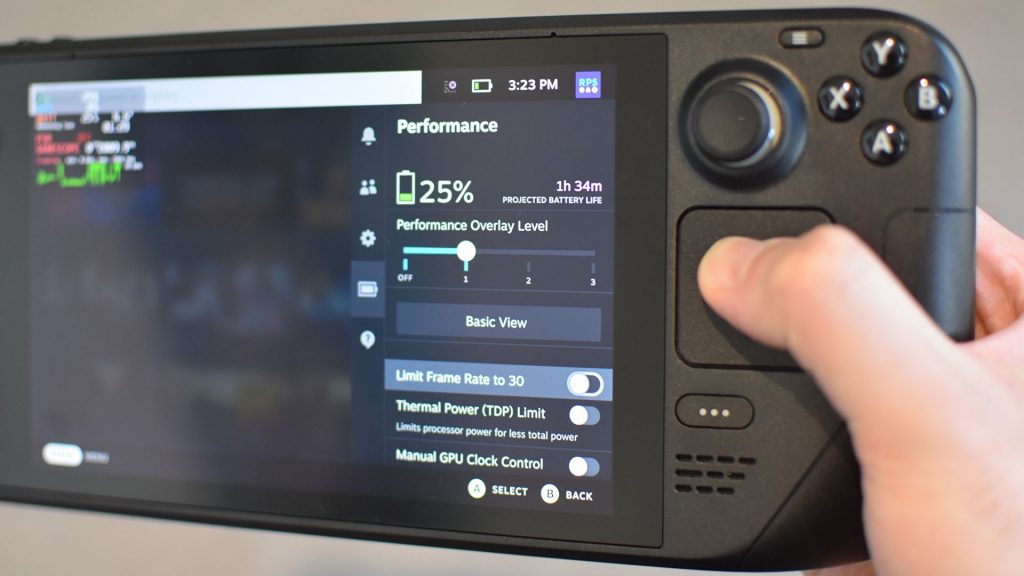The Steam Deck is the latest high-profile attempt to do the near-impossible – make a great handheld gaming PC. The device looks a lot like a Nintendo Switch, the current king of portable gaming, but it’s a very different beast: more powerful, more expensive and certainly more complicated. For the uninitiated, this is an AMD-powered handheld gaming PC with a 7-inch 1,280×800 display and either 64GB, 256GB or 512GB of storage.
It’s certainly an ambitious task, but one that Valve mostly pulls off. However, as much as you may think the Steam Deck is a Nintendo Switch rival, it’s actually more of an alternative to gaming laptops.
This means if you’re a PC gamer with a large Steam library, and you’re used to the quirks and annoyances that come with playing PC games, then you’ll likely love the Steam Deck and overlook its rougher edges.
However, if you’re a console player who’s used to more polished products that keep things as simple and straightforward as possible, you may be disappointed.
You can plug in pretty much any USB-C hub, hook up a monitor or TV and play games on the big screen. You can also use the Steam Deck in desktop mode, allowing you to install a variety of Linux apps, turning the Steam Deck into a fully-fledged mini PC. You can even install other operating systems, such as Windows 11.
This versatility puts the Steam Deck above its traditional competitors, and while people looking for a Nintendo Switch-like experience may not be sold, for PC gamers thinking about getting a gaming laptop, the Steam Deck is a brilliant device with a huge amount of potential, especially for people who like to tweak.

THE SPECS
CPU: 4-core AMD Zen 2 (2.4–3.5GHz)
GPU: 8 compute unit AMD RDNA 2 (1–1.6GHz)
RAM: 16GB LPDDR5 @ 5,500MT/s 32-bit quad-channel
Storage: 64GB eMMC / 256GB or 512GB NVMe SSD
Display: 1280×800, 60Hz 7-inch IPS LCD touchscreen
Connectivity: Wi-Fi, Bluetooth, USB Type-C w/ DisplayPort 1.4
Battery: 40Whr
Size: 11.7 x 4.6 x 1.8-inch (298 x 117 x 49mm)
Weight: 1.48 lbs (673 grams)
Price: $399 (64GB) / $529 (256GB) / $649 (512GB)

Design
The size certainly takes some getting used to, especially if you’re used to smaller handhelds or traditional gamepads, and more frantic games like Hades can feel a bit uncomfortable.
However, the longer we spend with the Steam Deck, the more comfortable it becomes. On the front of the Steam Deck are two thumbsticks on each side of the screen, with capacitive touch sensors built-in, which Valve claims provide “a level of precision and comfort not found on other portable gaming devices”.
They certainly feel robust, responsive and accurate, and are the control method we use the most. Below the thumbsticks are two square trackpads, which offer mouse control for games that require them. They are similar to the trackpad on the Steam Controller and offer subtle haptic vibrations, which is a nice touch. However, we rarely use them.
Slightly above the left-hand thumbstick, there is a D-Pad, which is handy for 2D and retro games, and in the same position above the right-hand are four buttons: A, B, X and Y, laid out in the same position as on an Xbox controller.
There’s also a View button, Menu button, Steam button and Quick access button as well. This sometimes feels a little over the top, as it’s not always clear what the buttons do in certain contexts, and sometimes they double up functionality.
But, if you like buttons, you’ll love the Steam Deck! On the top of the Steam Deck, there are two volume buttons, a power button, two shoulder buttons (L1 and R1) and two triggers (L2 and R2). There’s also a headphone jack, USB-C port for charging and hooking up a USB hub, and status LED.
Still not enough buttons for you? Well, the good news is that there are four more on the back. While this certainly gives the Steam Deck a certain amount of versatility, especially when playing PC games that require hotkeys that would usually be found on a keyboard, we never really use them in the games we play. While having more buttons than is necessary is better than not having enough, these extra buttons do sometimes get in the way, as you can accidentally hit them when holding or picking up the Steam Deck, which can have unwanted consequences when playing a game.
At the front of the Steam Deck, there are also stereo speakers and two microphones, allowing you to speak clearly to your teammates without needing a headset.

Performance
The performance of the Steam Deck is a mixed bag, at times seriously impressing us, and other times frustrated. When it comes to the frustrations, a lot of it is due to running an early version of Steam OS, with Valve pushing out updates and fixes almost daily.
There will also be some games that are labeled ‘Unsupported’. Due to the sheer size of Steam’s library, there will likely be plenty of games that fall under this category, especially more obscure titles. This doesn’t mean they won’t play at all, but there may be bugs, uncooperative interfaces or text that doesn’t look quite right.
Thankfully, the Steam Deck has plenty of options that allows you to tweak the game to run better. Making some games full screen – rather than windowed – and adjusting the resolution makes them run better. There are also numerous pre-made controller options to help you find the best control scheme for a game, especially one that’s not been designed for controller use.
The good news is that generally we have no issues playing any games that were Steam Deck Verified, with all the default settings working well. Stick with these if you don’t like messing around with options.
We did knock God of War down from ‘Ultra’ settings to ‘High’, for more consistent performance, and on the 7-inch screen it looks phenomenal, it never dips below 30 fps, and mainly stays around 40 fps.
You can install Windows 11 on the Steam Deck. This gives you a greater choice of games, as you’ll be able to install non-Steam Windows-only games from developers like Ubisoft and Activision Blizzard, who don’t publish on Steam.
Overall performance of the Steam Deck impressed us, with it handling both graphically impressive AAA titles and indie games well. Due to the form factor and overall hardware, we found the Steam Deck to particularly excel at indie games that you can pick up and play, rather than the cinematic games or titles with overly complex controls.
Battery life
Unfortunately during our time with the Steam Deck, battery life is an issue. When playing God of War, the Steam Deck lasts just one and a half hours on battery, below the two-hour minimum Valve claims. Obviously, this is a particularly intensive game, but it means playing games for long periods of time without charging the Steam Deck isn’t possible.
That’s going to upset a lot of people who may have been planning on using the Steam Deck for long flights, for example. There are things you can do to prolong the Steam Deck, such as turning down settings or using a battery pack, and because it charges via USB-C it should be easy to charge it a bit when needed, but it certainly makes this portable gaming system feel less… well, portable.
The good news is that when playing less intensive games, battery life is much better, with 2D games giving us hours of enjoyment over multiple play sessions.
So finally, The Steam Deck is a promising handheld gaming system with several wrinkles that need to be ironed out. It’s quite powerful for its size and price, and despite being a Linux-based device, it runs many excellent and recent Windows games extremely well.













